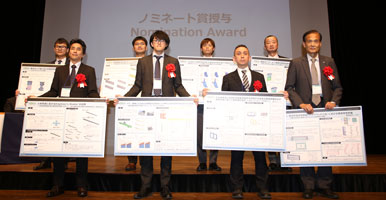| ●Date: November 15 (Eve), 16-18 (3Days), 2016 ●Venue: Shinagawa IntercityHall | (Up&Coming 2017 New Year issue) |
| Day 3 (Nov. 18) | The 10th Design Conference Seismic, Geotechnical and Water Works Sessions |
|
Seeking for Approaches to the Future Public Works Projects in Response to Social Environment and Changes in Needs
For Design Festival Day3, <Seismic, Geotechnical and Water Works Sessions> of "the 10th Design Conference" was held during the morning to the first part of the afternoon on Nov. 18, 2016 in the Shinagawa Intercity Hall. In the second part of the afternoon was held the award ceremony of "The 3rd National Resilience Design Award (NaRDA)" with announcement of prizes.
| After the host organizer's opening address, Mr. Keiichiro Asao, Member of the House of Representatives gave the first special lecture for Day3 entitled "Public works that contribute to the productivity improvement in the depopulating society". First, he mentioned the political problems for Japan in mid and long terms as follows: 1) Progress in depopulation and aging, 2) Remarkable increase in the social security expenditure such as the health insurance system that is comparatively rich internationally and the medical expense defrayal that is increasing along with the progress in medical technology, and 3) Reduction in public works expenditure in the circumstances owing a too enormous debt to get into more debt. However, in the present situation that roads, water supply and sewerage, and public buildings are getting into renewal timing even during the depopulation period, it is inevitable to select renewal investment. | 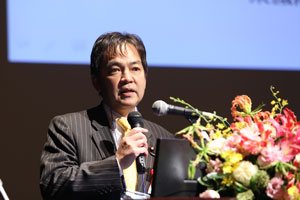 |
| ■Mr. Keiichiro Asao, Member of the House of Representatives |
|
| On the other hand, he presented the significance of a shift to compact cities for the solution for improving efficiency of services such as medical care or nursing care. According to him, it will be important for community planning to allocate priorities to activities by examining the age structure of the concerned cities, including compact cities mentioned above. It will also be important to make the best use of Japanese uniqueness such as locality and national characteristics not to cause dissatisfaction with present situations, which was seen abroad in the case of BREXIT and Trump phenomenon. He is looking forward to using VR for simulating people's movement etc. as a potential approach to such community planning. | |
| Next, Prof. Edwin Galea, Director Fire Safety Engineering Group (FSEG),
University of Greenwich, U.K. gave a special lecture entitled "Engineering
Safety, Security and Efficiency through Simulation". First, he introduced
the profile of FSEG and examples of modeling safety and security, applications
of FSEG software, and data collection. Then he explained the concept of
"Safety and security in crowded places" and specific examples
of disasters. Showing a wide variety of applications of agent-based evacuation
simulation (EXODUS), he mentioned its possibilities. Taking stadiums and
high rise buildings as examples, he expounded the effect on crowdedness
and evacuation time brought by modifying the evacuation scenario. He then introduced the research results that prove the advantage of evacuation using lifts and its simulation, and comparative simulation for improving efficiency in overall evacuation by clearing the crowdedness in a high-rise building. In addition, he explained the following items: 1) Effects of security bollards on counter-terrorism and mitigation of crowdedness, 2) More efficient uses of escalators to save time during rush hour (to walk or not), and 3) Verification results of experiments and modeling about urban scale evacuation and crowd dynamics. |
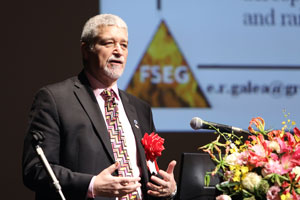 |
| ■Prof. Edwin Galea, Director Fire Safety Engineering Group (FSEG), University of Greenwich, U.K. |
|
| Moreover, he also mentioned support for large-scale disasters by EXODUS and SMARTFIRE including two new tools "urbanEXODUS" and "webEXODUS", FSEG's contribution to counter-terrorism training using automated serious game environment with MR (mixed reality), linkage with EXODUS and SMARTFIRE, and support for explosion modeling. | |
| Sessions in the afternoon started with Prof. Hiroshi Mutsuyoshi, Professor of Graduate School of Science and Engineering / Director of International Institute for Resilient Society, Saitama University, who gave a special lecture entitled "Transition of bridge technology – toward tough and long-lasting bridge". First, he explained the definition of external cable structure (external prestressing) and the difference from internal cables, and their characteristics based on the results of experiments and analyses etc. Then he developed his discussion into the structural advantage of a 2-span prestressed concrete girder bridge with external tendons of large eccentricity, the results of experiments and analyses about flexibility of its design, application of the structure to an actual bridge (Torisaki River Park Bridge) by joint study, and the construction process to completion of the bridge. He then compared the differences in the resembled structures of the general prestressed concrete girder bridge with external tendons, the prestressed concrete cable-stayed bridge, and the extradosed prestressed concrete bridge. | 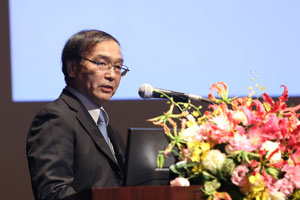 |
| ■Prof. Hiroshi Mutsuyoshi, Professor of Graduate School of Science and
Engineering / Director of International Institute for Resilient Society, Saitama University |
|
| On the other hand, he summarized actual domestic and overseas examples of aging degradation of prestressed concrete bridge etc., and external and internal factors that influence degradation of bridges and problems to solve. This was followed by introduction of his own studies for prolonging the life of bridges with experimental results etc. as follows: 1) study on dynamic characteristics of prestressed concrete girders with broken prestressed concrete steel, 2) Development of PC grout for reinjection mixed with ion exchange resin, and 3) Development of technology of restoring cracks in concrete using microorganisms. Furthermore, he expounded the requirements for providing the bridges newly constructed or renewed in the future with high durability from the following points of view: 1) Structural rationality, 2) Multilayer protection, and 3) Easy inspection. Finally, he mentioned the process of modification of new Specifications for Highway Bridges under review, as well as the related points in the current modification. | |
The sessions were closed by "IM&VR, presentation of the nation strengthening solution". The first part was entitled "FEM analysis series, the latest products and their functions", with FORUM8 staff in charge talking about the characteristics and main functions, and new functions of the latest versions of Engineer’s Studio®, WCOMD Studio, GeoFEAS Flow 3D, and FEMLEEG, showing demonstration of operational procedures. He also mentioned the development plans of these products for the future.
The second part was entitled "BIM/CIM world expanded by FORUM8" with presentation made by FORUM8 staff in charge. He introduced the concept of IM&VR and a wide range of product lineup to cover BIM/CIM, development progress of main products and their major functions, diverse examples of VR simulation linked with other analysis results and data created, services, a simulation lineup, and product linkage with 3DCAD Studio® as its core.
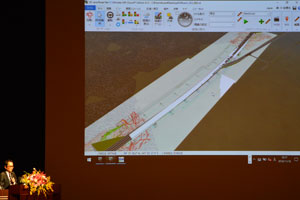 |
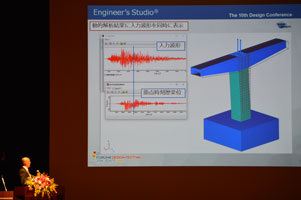 |
| ■Katsumi Matsuda, Executive Officer and System Sales Manager of FORUM8 |
■Masakichi Yanagi, Leader of Analysis Assistance Team, UC-1 Development 1st Group, FORUM8 |

| The 3rd National Resilience Design Award | |
Hoping for New Points of View, from Diverse Technological Proposals to Engineer Education
In the second part of the Day3 in the afternoon, Design Festival of the year was closed by the announcement of prizes and award ceremony for "the 3rd National Resilience Design Award (NaRDA)". Three judges of NaRDA of this year included Prof. Hiromichi Yoshikawa (Chief of the judging committee), Professor of Earthquake Disaster Mitigation Engineering, Tokyo City University; Prof. Masaru Morita, Vice-president of Shibaura Institute of Technology, Professor of Urban Environmental Engineering Laboratory, Civil Engineering Department, Shibaura Institute of Technology; and Prof. Akihiko Wakai, Professor of Science and Engineering Department, Gunma University, who joined the committee newly this time. After introducing judges, Prof. Yoshikawa, Chief of the judging committee started by explaining the point of NaRDA.

